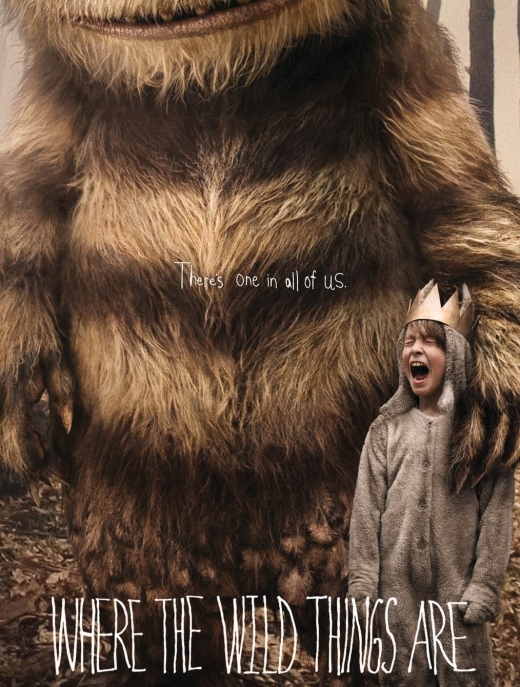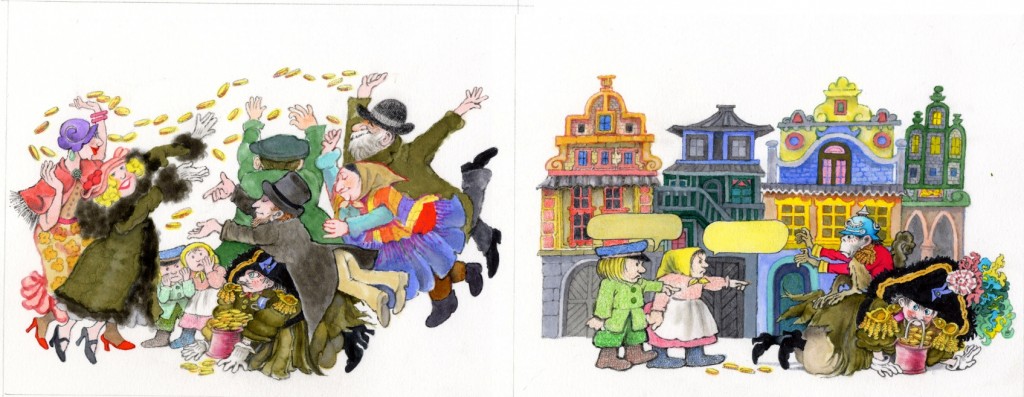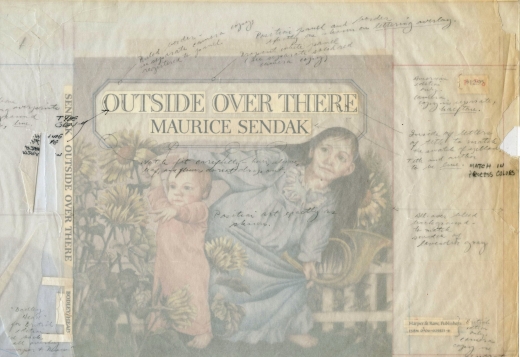![]() BY JONATHAN VALANIA Where The Wild Things Are creator Maurice Sendak is, in many ways, the dark side Doppelganger of Dr. Seuss and taken together they represent the twin titans of 20th Century children’s literature. If Dr. Seuss’ work vibes like a drug-free acid trip for children aged 8 to 80, then Sendak’s oeuvre is, to extend the metaphor, like Vicodin for the soul, numbing tender-aged psyches from the pain of growing up in a desultory world of de-saturated colors and unrelieved melancholia where adults do monstrous things to each other, and sometimes to children, too. There were two formative experiences in the 84-year-old Sendak’s childhood that imprinted indelibly on his being and have haunted his work for more than 60 years. The first was the mysterious kidnapping and brutal murder of Charles Augustus Lindbergh Jr., the 18-month-old toddler scion of famed aviator Charles Lindbergh. The second was The Holocaust, where six million men, women and children were exterminated for the crime of believing in the wrong god. Intimations of these horrors can be found in Sendak’s illustrations for the Holocaust-themed Brundibar, his 2003 collaboration with Tony Kushner, and Outside Over There, Sendak’s 1981 story about a young girl named Ida who has to rescue her baby sister after she is stolen away in the night by goblins. Both of these works, along with The Sign On Rosie’s Door from 1981, comprise a new exhibit at Philadelphia’s Rosenbach Museum called From Pen to Publisher: The Life of Three Sendak Picture Books. Sendak has chosen the Rosenbach as the final repository for his expansive artistic legacy, donating thousands of artifacts from his private archives to the museum with the understanding that it would preserve and puzzle together the narratives of his long and storied career as author and illustrator. In From Pen To Publisher, the Rosenbach goes meta, pulling back the curtain on Sendak’s process and revealing how his books start out as inspired, annotated doodles and gradually morph into iconic totems of illustrated storytelling for children of all ages. We recently stopped by the Rosenbach to check out the exhibit and sit down for a Q&A with curator Patrick Rodgers.
BY JONATHAN VALANIA Where The Wild Things Are creator Maurice Sendak is, in many ways, the dark side Doppelganger of Dr. Seuss and taken together they represent the twin titans of 20th Century children’s literature. If Dr. Seuss’ work vibes like a drug-free acid trip for children aged 8 to 80, then Sendak’s oeuvre is, to extend the metaphor, like Vicodin for the soul, numbing tender-aged psyches from the pain of growing up in a desultory world of de-saturated colors and unrelieved melancholia where adults do monstrous things to each other, and sometimes to children, too. There were two formative experiences in the 84-year-old Sendak’s childhood that imprinted indelibly on his being and have haunted his work for more than 60 years. The first was the mysterious kidnapping and brutal murder of Charles Augustus Lindbergh Jr., the 18-month-old toddler scion of famed aviator Charles Lindbergh. The second was The Holocaust, where six million men, women and children were exterminated for the crime of believing in the wrong god. Intimations of these horrors can be found in Sendak’s illustrations for the Holocaust-themed Brundibar, his 2003 collaboration with Tony Kushner, and Outside Over There, Sendak’s 1981 story about a young girl named Ida who has to rescue her baby sister after she is stolen away in the night by goblins. Both of these works, along with The Sign On Rosie’s Door from 1981, comprise a new exhibit at Philadelphia’s Rosenbach Museum called From Pen to Publisher: The Life of Three Sendak Picture Books. Sendak has chosen the Rosenbach as the final repository for his expansive artistic legacy, donating thousands of artifacts from his private archives to the museum with the understanding that it would preserve and puzzle together the narratives of his long and storied career as author and illustrator. In From Pen To Publisher, the Rosenbach goes meta, pulling back the curtain on Sendak’s process and revealing how his books start out as inspired, annotated doodles and gradually morph into iconic totems of illustrated storytelling for children of all ages. We recently stopped by the Rosenbach to check out the exhibit and sit down for a Q&A with curator Patrick Rodgers.
PHAWKER: A lot of Phawker readers – and many Philadelphians, for that matter – may not know what the Rosenbach Museum is all about. Why don’t you tell us?
PATRICK RODGERS: Sure! We were founded in the early 1950’s by the two brothers who passed away back in 1954 and left their collection to the public, basically. The Rosenbach brothers — the older brother, Philip, the younger brother, Dr. A.S.W. Rosenbach [pictured, right] – had a company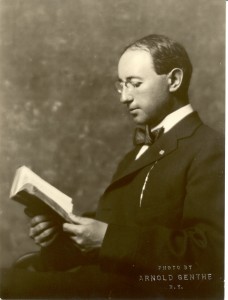 called the Rosenbach Company and they bought and sold rare books, manuscripts, and fine and decorative arts. The pieces that they didn’t sell they held on to and kept, and that is what now forms the basis of the collection. That includes tens of thousands of rare books, including first editions and presentation copies and things like that. There’s a really large section of Americana, which includes stuff like Lincoln documents, Founding Fathers’ letters, Civil War documents, and things like that. That was sort of the core collection that was here in the ‘50s and it’s been here since, but we’ve added to it over the years and in the 1970’s the poet Marianne Moore felt this kinship with the museum and the collection and donated her entire archive here. Not long thereafter, Maurice Sendak also felt the same kinship and began to leave his works on deposit here. So, it’s been sort of snowballing since then among those collectors who really feel an affinity for what the Rosenbach brothers had originally collected.
called the Rosenbach Company and they bought and sold rare books, manuscripts, and fine and decorative arts. The pieces that they didn’t sell they held on to and kept, and that is what now forms the basis of the collection. That includes tens of thousands of rare books, including first editions and presentation copies and things like that. There’s a really large section of Americana, which includes stuff like Lincoln documents, Founding Fathers’ letters, Civil War documents, and things like that. That was sort of the core collection that was here in the ‘50s and it’s been here since, but we’ve added to it over the years and in the 1970’s the poet Marianne Moore felt this kinship with the museum and the collection and donated her entire archive here. Not long thereafter, Maurice Sendak also felt the same kinship and began to leave his works on deposit here. So, it’s been sort of snowballing since then among those collectors who really feel an affinity for what the Rosenbach brothers had originally collected.
PHAWKER: And the museum is housed in Rosenbach’s house, correct?
PATRICK RODGERS: Correct. It’s an 1865 townhouse located at 2008 Delancey Street.
PHAWKER: Tell us the story about the Widener scion that was working for Rosenbach and was aboard the Titanic when it went down.
PATRICK RODGERS: I’m probably not as knowledgeable about this as other staff, but we just opened this exhibition yesterday and it’s really fascinating. The gentleman was Harry Widener, as you said, who was a protégé of Dr. Rosenbach when Dr. Rosenbach was an up-and-coming rare book dealer who was just beginning to really break into the business worldwide as a rare book buyer and seller. He was advising Harry, and Harry really got the bug for bibliomania as Dr. Rosenbach might have called it. He went over tot England on a buying trip with his father, his mother, and their maid, and was able to find some spectacular things to bring back to this country, including an edition Francis Bacon’s essays – which was a very rare edition. Dr. Rosenbach was very pleased, but unfortunately they chose the Titanic to come back on and Harry Weidener, his father, and those Bacon essays in Harry’s pocket went down with the ship. Harry’s mother and the maid escaped in a lifeboat, just barely. Not long there after while this was all going on – the search for survivors was going on – Dr. Rosenbach was in touch with his English counterparts and they were really trying to see what news on Harry they could learn, and Harry’s family as well. Harry was never found, although everybody said to look for that edition of Bacon in his pocket as a way to identify him if he was. Eventually Harry’s mother felt that the most fitting tribute for her son would be the building of a library – which had always been Harry’s dream – and she asked Dr. Rosenbach if he would help her build a magnificent library in Harry’s honor, and he absolutely and enthusiastically agreed. That’s how they sort of built the Widener Library in Harvard, so that institution is really sort of based on the relationship between Dr. Rosenbach and the Widener family.
PHAWKER: How many titles are under your roof or in the museum’s possession?
PATRICK RODGERS: It’s something like 386,000 objects and library materials, although that includes best guesses as to uncatalogued portions of the collection and reference materials and things like that. References not included in that, sorry. So we’re sort of nearing around 400,000 objects.
PHAWKER: Wow. Moving on to the purpose of our conversation — to promote the new Sendak exhibit — can you talk a little about who is Maurice Sendak, for the benefit of readers who didn’t grow up with his books.
PATRICK RODGERS: Oh, sure. Sendak is a picture book artist and illustrator. He’s been illustrating books since the late ‘40s and he’s a largely self-taught artist. He took lessons and had been sketching since he was a kid, and really sort of worked his way into the profession in the late ‘40s. So, when he had moved to New York and he was getting to know people and he illustrated a book in 1951 called A Hole Is to Dig and it was sort of a quiet revolution in children’s books. It was a picture book without a particular plot, and it included little aphorisms and sayings that came out of kids’ own language. It was a very kid-centric book and it really sort of made a mark on children’s publishing as something that had never been done before, as Sendak had these very bouncy little vignettes that went through the whole book. That sort of marked a real launching point for Sendak as somebody who was really attuned to kid sensibilities and to surprising adults, I think, with the versatility of the kind of artwork that he did. Then he went on to do books like Where the Wild Things Are, which is probably his most well known, in 1963. It’s in a very different style than a lot of books that he had done previously, and it has these really vivid characters in it that still fascinate people today, which is why it’s such a selling book. I’ve mentioned 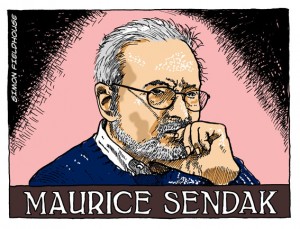 two books here, but he illustrated something like 93 books or something. Sometimes it’s difficult to count what set of illustrations might constitute a particular book, but the number is above 90 and just shy of 100, although he’s sort of getting there and he’s still publishing. So his career goes from his first published book in 1947 or 1948 up to the most recent one, which was published in September of last year. So he’s always been a really prolific illustrator as well. You know, when I was a kid anyway I grew up with at least three of his books and I’ve come to find other ones as an adult and the range is really astounding. He’s illustrated Herman Melville, he’s illustrated Leo Tolstoy, he’s illustrated 19th century German plays, and then he’s done comedic kind of kids books, he’s done the Brothers’ Grimm – he’s really all over the place and he changes his style with so many of his books that one of the reasons we really like doing exhibitions of him here is that he really keeps you guessing. There’s no formity of what you’re seeing. It’s always giving you something new. The collection here – although, again, we don’t have a really solid figure – is probably around 10,000 pieces, which is several thousand works of art and probably at least twice as many working materials for his books, a lot of which you saw in the Pent-Up Publisher exhibition. With a collection that large, we’re really able to theme after theme in his artwork and show different types of Sendak, different types of what he puts into his illustrations, and all of the mysteries that he’s sort of embedding in so many of his pictures to literary references and historical references and all of those things. I think he’s one of these artists who a lot that people know on one level when they’re young, having read his books, but when they rediscover him when they’re older, they’re really kind of astounded at how prolific and nuanced his illustrations are, so that’s one way to approach him, I guess.
two books here, but he illustrated something like 93 books or something. Sometimes it’s difficult to count what set of illustrations might constitute a particular book, but the number is above 90 and just shy of 100, although he’s sort of getting there and he’s still publishing. So his career goes from his first published book in 1947 or 1948 up to the most recent one, which was published in September of last year. So he’s always been a really prolific illustrator as well. You know, when I was a kid anyway I grew up with at least three of his books and I’ve come to find other ones as an adult and the range is really astounding. He’s illustrated Herman Melville, he’s illustrated Leo Tolstoy, he’s illustrated 19th century German plays, and then he’s done comedic kind of kids books, he’s done the Brothers’ Grimm – he’s really all over the place and he changes his style with so many of his books that one of the reasons we really like doing exhibitions of him here is that he really keeps you guessing. There’s no formity of what you’re seeing. It’s always giving you something new. The collection here – although, again, we don’t have a really solid figure – is probably around 10,000 pieces, which is several thousand works of art and probably at least twice as many working materials for his books, a lot of which you saw in the Pent-Up Publisher exhibition. With a collection that large, we’re really able to theme after theme in his artwork and show different types of Sendak, different types of what he puts into his illustrations, and all of the mysteries that he’s sort of embedding in so many of his pictures to literary references and historical references and all of those things. I think he’s one of these artists who a lot that people know on one level when they’re young, having read his books, but when they rediscover him when they’re older, they’re really kind of astounded at how prolific and nuanced his illustrations are, so that’s one way to approach him, I guess.
PHAWKER: Okay, and now let’s talk about the exhibit that sparked this conversation about. It’s called…
PATRICK RODGERS: It’s called From Pen to Publisher: The Life of Three Sendak Picture Books. It’s really a look at the life cycle of a picture book, what a picture book goes through from its initial creation, all the way through the publication process. You know, from the first time that the artist puts their pen down on a page with that brilliant idea, to the press proofs that get corrected, and trying to figure out how to correct things like color. The three books that we’re sort of showing the life cycle of are three Sendak books, one of which is The Sign on Rosie’s Door, which he published in 1960. The other is Outside Over There, which comes from 1981, and the last is Brundibár, which is from 2003. We chose those three books because of the wealth of the materials related to them in the collection, but also because it showed his great range in how Sendak developed the book and how his publication processes has changed. So the work he did and the way that he approached color in his artwork in 1960 was very different from the way he did it in 2001, which is when he first saw Brundibár, for example. So we thought those books would be really compelling for visitors to sort of mine and see how he approached each book in incredibly different ways, and yet there’s a lot of threads that connect them. For example, between The 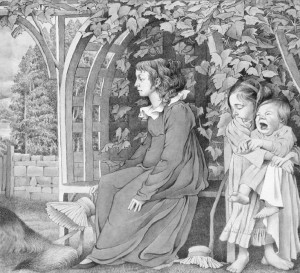 Sign on Rosie’s Door and Outside Over There, there are even characters that have some overlap between those books even though they’re more than twenty years apart. So visitors will really get to see the development up close. Everything from the scraps of paper that he was jotting ideas down on initially when he was working on these books, all the way through correspondence with his publisher, designs for dust jackets…one of the fun things about this show is that it really gives you a sense of how much artistry goes into a book. You can’t get all of that, I think, when you have it in your hands and when you’re reading it, but you might not be totally conscious of it. You might not be totally conscious of who did the type, how was it selected, what kind of binding is it, how does that jive with the design, how is the illustration spaced and laid out in relation to the text. All of the choices that go into it are interesting ones, so we wanted to show that process and how those choices got made as each book got developed – and who made them, you know? This show is a Sendak show, but we bring in a lot of his circle. The people he worked with: the other artists, the authors, the editors, the copywriters, and the whole cast of characters that it takes to make a book.
Sign on Rosie’s Door and Outside Over There, there are even characters that have some overlap between those books even though they’re more than twenty years apart. So visitors will really get to see the development up close. Everything from the scraps of paper that he was jotting ideas down on initially when he was working on these books, all the way through correspondence with his publisher, designs for dust jackets…one of the fun things about this show is that it really gives you a sense of how much artistry goes into a book. You can’t get all of that, I think, when you have it in your hands and when you’re reading it, but you might not be totally conscious of it. You might not be totally conscious of who did the type, how was it selected, what kind of binding is it, how does that jive with the design, how is the illustration spaced and laid out in relation to the text. All of the choices that go into it are interesting ones, so we wanted to show that process and how those choices got made as each book got developed – and who made them, you know? This show is a Sendak show, but we bring in a lot of his circle. The people he worked with: the other artists, the authors, the editors, the copywriters, and the whole cast of characters that it takes to make a book.
PHAWKER: One of the illustrations that’s on display there is sort of a bizarre, surrealistic, um…Oh, I don’t know – what is it, a pack of baby monsters?
PATRICK RODGERS: Oh, the babies in that one illustration?
PHAWKER: Yeah, can you speak to that a little bit? How is that connected to the Lindbergh kidnapping?
PATRICK RODGERS: Yeah, that’s a particularly interesting story relating to Outside Over There. One of the first materials visitors will see on display is a typed story – it’s a story by the Brothers’ Grimm called The Goblin. Sendak had illustrated that in 1973, but after he did the illustration it really stuck with him. The reason it stuck with him is because when he was a kid, there was a high-profile kidnapping of Charles Lindbergh’s son. It really sent waves of terror across the country, and the media insanity following the kidnapping and the eventual trial of the supposed kidnapper was totally unprecedented. The Sendak family, and the four year old Maurice were watching and listening very closely, and he still remembers that event and the horror that it sort of struck into every family. That Grimm Brothers tale about The Goblin included the idea of these goblins snatching babies; that they came into your house and took your baby and left a changeling in its place. That kind of idea stuck with him, so later in the ‘70s he really wanted to create a picture book about that idea of goblins stealing a baby and trying to fool someone with a false baby. So he started Outside Over There sort of from that idea, and it includes these goblins that look like really short creatures wearing purple robes – and you can’t see their faces, so they’re very evocative of a death-like figure and they steal the baby sister of the main character, named Ida. Later in the book, if I’m not giving too much away, Ida goes to where the goblins live and she’s able to discover that the goblins are all babies. They’re sort of corrupted babies, actually, and she’s able to save her sister from them. The illustrations for it are really sort of otherworldly. The goblin babies live in this sort of fantastical cave, and Ida’s able to charm them and actually sort of melt them by playing a tune that gets them dancing into a frenzy, which is also borrowed from the original Grimm tale. It’s a really interesting example of how Sendak will take a literary source and sort of twin it with something from his own experience, background, or life, and create something new out of it. A whole new picture book, or a whole new work of art, so Outside Over There is a really interesting one for those who don’t know it.
PHAWKER: Let’s talk a little bit about the Sendak family and their connection to The Holocaust.
PATRICK RODGERS: Sure. Well, concerning Sendak’s family, I suppose, Sendak’s parents grew up in Northern Poland and they were both Jews who had left for America prior to World War I. They met while they were here – they didn’t come together. But they met here, married here, and began to bring Sarah Sendak’s family over at that point when they had saved up enough money, and they tried to do that as often as they could. They tried to bring Philip Sendak’s family over, but they had three kids, money was coming in slower, and Europe was starting to tighten up. Before they could get anybody out of Poland, World War II happened and the Nazis had invaded in ’39. Philip’s family was sort of trapped there, and they learned – I think, somewhere in 1941 – that his father’s village had been liquidated. Almost all of his father’s family, his father’s uncles, aunts, and everyone were sent to concentration camps and died there. Sendak was growing up, I think he had just had his bat mitzvah when he learned about all of these deaths and grew up with that knowledge of a family that he had never met being wiped out. And of course by his father’s grief as well, that has been a motivating force throughout most of his career and a lot of his artwork. Books like Dear Mili, which is sort of a sequel to Outside Over There, sort of follow a lot of Holocaust themes. When it came to Brundibár, he really wanted to sort of tackle the topic head on because Brundibár itself is a product of the Holocaust. Its creator was a composer named Hans Krása, who was a Czech Jew who wrote this play in 1938 – it’s actually a children’s opera about these two kids taking on these town square bullies who won’t let them sing in the town square and earn money to heal their sick mother. It’s sort of an allegory about Nazi Germany, and what he thought was going to imminently happen to Czechoslovakia.
When it did happen to his country, he was sent to a Nazi ghetto for Jews in Czechoslovakia, and while he was in there he was interned with a lot of other Jewish intellectuals – musicians, poets, and writers, and it became sort of a hotbed of culture at the time. They were able to perform Brundibár with music and a children’s chorus about fifty times while Jews were interned there. During and after these performances, a lot of people from the ghetto were being shipped off to death camps, as was Krása himself. Not many people had survived that, and it was a really difficult story to take up but Sendak and Tony Kushner took it up around 1999 or so and decided that they not only wanted to do a picture book, but also revise the children’s opera and get it going as an opera again. So they did, and by 2003 they had both out there – the picture book and the children’s opera. So that’s where that sort of comes in, and in this exhibition the Brundibár materials just show Sendak and Kushner trying to tackle this really difficult topic, and in particular the villain was really a tough one to crack, basically. Sendak approached it initially with the idea that his villain would be almost a direct portrayal of Adolf Hitler, and a lot of his initial sketches of it show a sort of a Hitler character griping or hurdy-gurdying. You know, it’s comic, but it’s a fairly realistic portrayal in a lot of pictures and in some of them it looks like he’s sort of working from photographs, even. At some point, he and Kushner talked about this and realized that it was pulling something out of context and that the book didn’t feel right with that villain. So the sketches that we have on display show that transition from a sort of Hitler-like villain to this odd, amalgamated villain who has this vaguely Napoleonic costume but he’s got this sort of Hitler-ish eye, but he’s a little Stalin-ish too. He’s sort of the composite bully, basically, that Sendak adapted. So it’s really interesting to see how that particular character — you know — what it took for him to let go of wanting to get even with his original impulse for it, and creating something new and a little more nuanced and ultimately more satisfying at the end.
PHAWKER: Do you think that that’s part of the reason why Sendak appeals to both the very young and grown-ups as well? Because his world view is informed by these brushes with pure evil that he encountered as a child, i.e. the Nazis and the Lindbergh kidnappers. The murder of the Lindbergh baby was really horrific. If I remember correctly, they grabbed him by the ankles and just basically swung him like a baseball bat and just bludgeoned him against a wall.
PATRICK RODGERS: Oh, wow. Yeah, I don’t know how he was killed, but…
PHAWKER: Sorry to get so graphic there on you. But anyway, if you could just maybe speak to that. You know, I think a lot of people think of children’s books as being all sunshine and lollipops, and Sendak isn’t.
PATRICK RODGERS: Yeah, I think so. Yeah, I mean, he has an interest in a range of what kids kind of go through. There’s a book that he did in the early ‘90s about homeless kids called We Are All in the Dumps with Jack and Guy, and kids live that reality. If kids can live it, artists can represent it, and other kids can read about. He doesn’t shy away from whatever reality might be out there, whether it’s something horrible that he’s experienced that he wants to transmit to his artwork, or whether it’s a horrible experience that he’s retelling or he’s interpreting – it just fascinates him. You know, whether it’s the Lindbergh kidnapping or a contemporary problem like child homelessness, basically. I think those are stories that he doesn’t want to shy away from, that he finds interesting within his medium of the picture book. Some people might think it’s unusual, but I think that he as an artist just kind of thinks that that’s his mission.
PHAWKER: So, just to end on an even more depressing note, I just heard on NPR last night that there are currently 1.3 million children that are homeless in America.
PATRICK RODGERS: Is that right? My god. Wow. No kidding. Well, if you ever get your hands on that book, We Are All in the Dumps with Jack and Guy, it’s a really interesting one and it’s come to be probably one of my favorite Sendak titles now.

